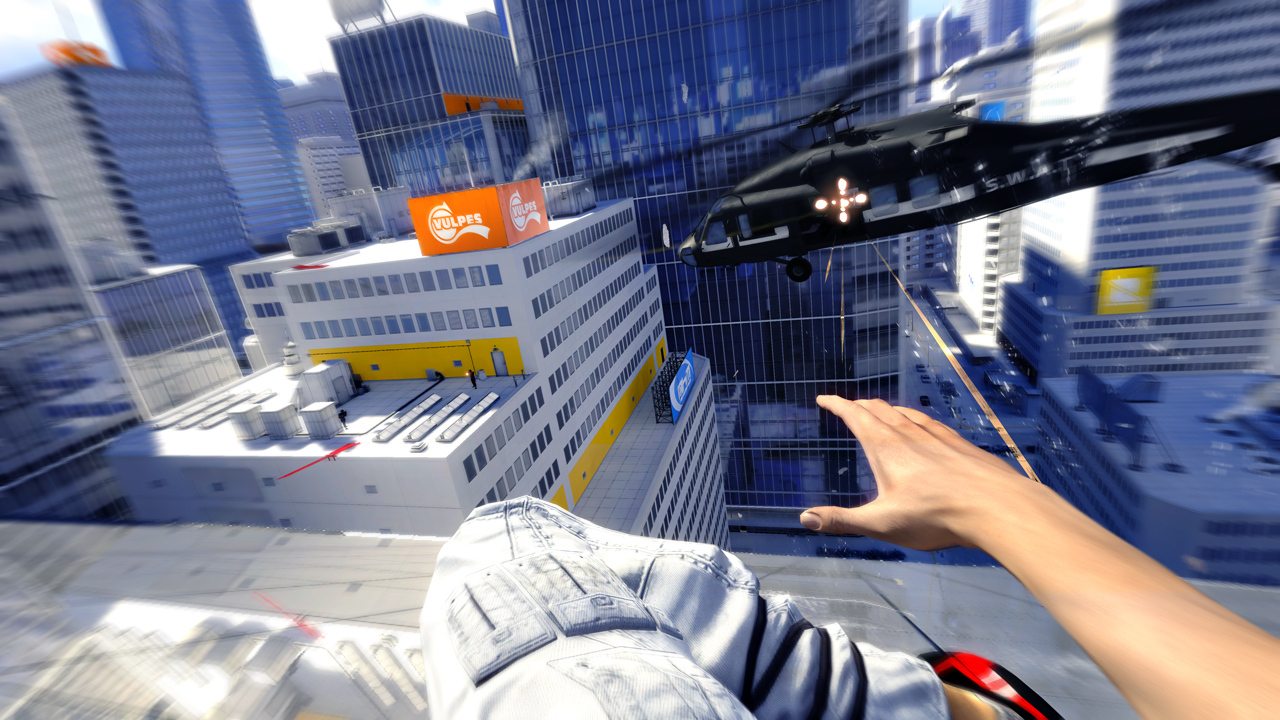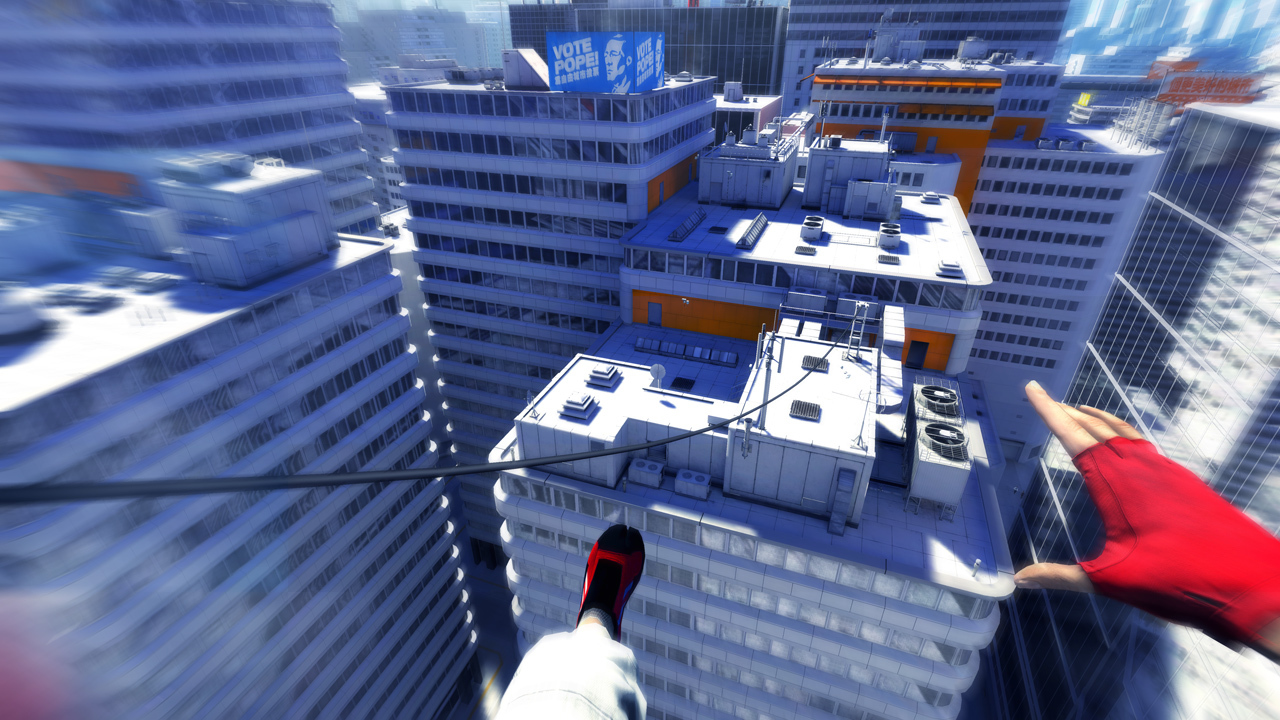Mirror’s Edge feels like a game made specifically for me. I’ve worked in offices, shopping centres, and warehouses and am now being asked to exploring highly stylised but authentic recreations of such spaces, using my new abilities to gain a mastery over these environments that I could never hope to achieve in my day to day life. It even borrows a move (the running slide) from Far Cry 2, which is fortunate as I’ve been attempting it in every game since. A few hours play and I had started to look at the world in a different way, no longer did I see window ledges, pipes, or rooftops. I saw paths, escape routes, leaps of Faith.
There’s even a subtle sense of the Looking Glass Studios aesthetic in the game mechanics: application of a limited set of tools to turn the environment to your advantage. In this case the parkour abilities of runner Faith instead of the elemental arrows of master thief Garrett.
Mirror’s Edge is at its best when being pursued. The pounding of your feet on the ground, the rush of the wind as you leap between buildings, the kinaesthetics are outstanding. There are times where all the elements gel and you are able to lose myself in its core fantasy…
Barging through a door I see the rooftops, a patchwork of stark white and grey metal spreading out ahead of me. I’m giddy, a child again, but the police are closing, they are armed I’m not. None of that matters, up here I have the power, this is my playground. I sprint to the right and leap off, tucking in my legs at the last moment I land with a roll on the building opposite. Moving again, losing no time, sliding under the pipes I need to get over that fence, how? There, that wall, that air conditioning unit. Two steps up the latter I turn, spring across to the wall then off again. Up and over the fence. I hit the ground hard, a stumble. Bullets chew the floor around me, but I’m still moving. Arms pumping heart pounding, a gap in the roof. No time to think about it I angle towards the wall my momentum taking me up and along over the gap…
Sorry forgot where I was for a minute…

Unfortunately such pure moments of sensation don’t last. Much too frequently you are faced with a jump or other obstacle that slows you down, that seems for a moment impossible to pass. A section that will inevitably lead to trial and error and death, repeated, unpleasant and rarely educational death.
At the heart of both those moments of total engagement and those of controller-snapping frustration lies a control system and movement list that is at once straightforward, intuitive and barely explained.
Beyond standard first person analog movement and camera controls there are only three buttons required for navigation of the environment; up, down and a 180 degree turn. Combinations of these are all that’s required to pull off even the most complex sequence of jumps and climbs. It’s context sensitive yet strangely intuitive. The simplicity of control strengthens the connection between you and Faith. Up is always up. Standing still it’s a simple jump, moving forward at speed it becomes a leap. Running towards a wall it’s a climb. Fast enough and you’ll take several steps up the wall before grabbing the top, too slow and you’ll clamber up and hang there.
This allows you to feel capable and skilled from the very beginning. Within minutes you are being asked to perform tricky manoeuvres and pulling them off with speed and style. Mirror’s Edge succeeds in making you feel skilled very quickly. The downside to this is that the tutorial only provides information on the more basic movements, with little subsequent reinforcement of those lessons. It is easy to forget certain options are available and therefore become frustrated when faced with an obstacle that requires a rarely used part of your movement vocabulary; Faith’s ability to press herself through narrow gaps, or jump backwards from a wall run being the most common culprits.
Besides these moments the only movements required for the majority of the game are variations on jumping, ducking, and wall running. With the need to only think about these base abilities movement at speed quickly becomes instinctive. Almost every obstacle can be overcome with one of these and enough momentum. Here is the core of Mirror’s Edge, conservation of momentum. The need to keep moving; to keep your speed high and carry it through into each subsequent move. It’s a vital concept that is described once early in the game and never expanded upon. There is little education or reinforcement regarding which moves help to conserve momentum and which don’t. This lack of clarity is compounded by the need to approach certain obstacles with a counter intuitive thought process. In order to retain the most momentum there are times where it is better to avoid the obvious path, sprinting around otherwise scalable obstacles because the direct path will slow you down too much.
With every ability available to you from the start the skill comes not from working out the required route but in finding and following a path that allows you to keep moving. It is a game to be played at full speed, every new rooftop analysed in the time it takes to make the leap onto it. The path over, under or around each obstacle selected moments before you reach it, will your momentum take you up over it or do you need to dart around the side? Keep moving, stop and you’re dead. There is barely time to look before you leap and what little you have needs to be spent looking ahead to the next jump. Everything has to be done two moves in advance, no time to look around when you get to the other side, you need to be moving, if you don’t they’ll be on you.

When you understand the abilities available, how they can be used and combined you find yourself stringing together convoluted routes with little conscious thought. Feet pounding, wind rushing past, the sense of speed, movement and mastery of your environment is incredible.
Fluid movement isn’t the only act required of you in Mirror’s Edge, or more specifically it is but the game seems to go out of its way to imply otherwise. Combat is an option, and often you are advised by you in-ear guide and mentor Mercury to “get ready for a fight” moments before making the jump into an areas with three or more hostile NPCs with a long climb up a pipe your only escape. The obvious impression is that you need to either incapacitate or kill everybody in the immediate area before attempting to climb the pipe. Although direct engagement is an option, and you have a number of ways of shifting the odds in your favour, combat is not one of Mirror’s Edge‘s strengths, and it does itself a disservice by implying otherwise. Especially as a little thought and a fair degree of cunning will allow you to get through each encounter engaging at most two hostiles and occasionally avoiding combat alltogether. Using your superior speed and athleticism, you can play cat and mouse with your pursuers, drawing them away from your escape route long enough for you to make a break for it. This style of avoidance based gameplay again has a distinct Thief vibe to it and feels like a truer fit to the core fantasy of being a free-runner than the timing based disarms and melee combat moves.
That is the core of where Mirror’s Edge falls down, it tries to over extend itself, break out of its own fantasy and be more than it is capable of. It’s a game about being smarter, faster and more capable than your adversaries. It’s not a game about guns, combat or revenge. It’s about fluid movement and mastery of a limited contextual move set. It’s not about getting stuck for nearly half an hour because your forgot some obscure ability it’s likely you were never actually told about in the first place.
When it remembers what it is best at it feels like no other game, but when it tries to be something it’s not or requires you to act in a manner contrary to that which the game mechanics imply is correct it fails. Levels are designed with an eye towards allowing you to pull off impressive moves yet they often require precise alignment that comes at the expense of the very speed required to achieve them successfully. It is a game that rewards mastery while failing to give you the information required to attain it. It is a game best played avoiding confrontation that goes out of its way to force it upon you.
When it works Mirrors Edge can be a joy, when it doesn’t it feels like a chore and there are few worse sins for a work of entertainment to commit.
4 replies on “Life on the Edge.”
I’ve only tried the PS3 demo of this game, but I must agree with the points you make. I thought this would be a definite buy for me, but I probably won’t get it; at least not before it hits the bargain bin.
I’m glad I discovered this blog. You’re a great writer. Keep rocking!
I can’t believe I didn’t think of this before. When I read the word “pursue,” I remembered how Mirror’s Edge evoked a favourite scene of mine. In Beyond Good & Evil, there’s a section near the end where Jade has to escape on foot across rooftops from a DomZ general. Given that’s probably the most exhilarating scene in one of my favourite games, that might have contributed to me being completely enamoured with Mirror’s Edge.
I think I just love the pursuit and the escape. Thief is another favourite of mine, and I like that you’ve drawn a connection here. I hadn’t thought of that, but the core objective in both Thief and Mirror’s Edge is quite similar.
I was never frustrated with the parkour sections. The only bits that got me were the combat and even that wasn’t too labourious (I did managed to finish with the Test of Faith achievement). When I hear people rail against (not saying you’re doing so, but others have), I genuinely wonder if we were playing the same game.
As an aside, I didn’t even know this was was possible: “jump backwards from a wall run”
Guess there really is something to be said about the lack in instruction, heh.
@Stephen: I’m probably the single worst person to ask that. I’ve bought games that I knew were bad simply because I wanted to see for myself why.
Try the demo, if you “get” the game and can see yourself playing with the same core mechanic for several hours it’s worth the experience, if you don’t you’ll be frustrated easily and want to throw things at the television.
Good post, so do you think its worth buying yet?